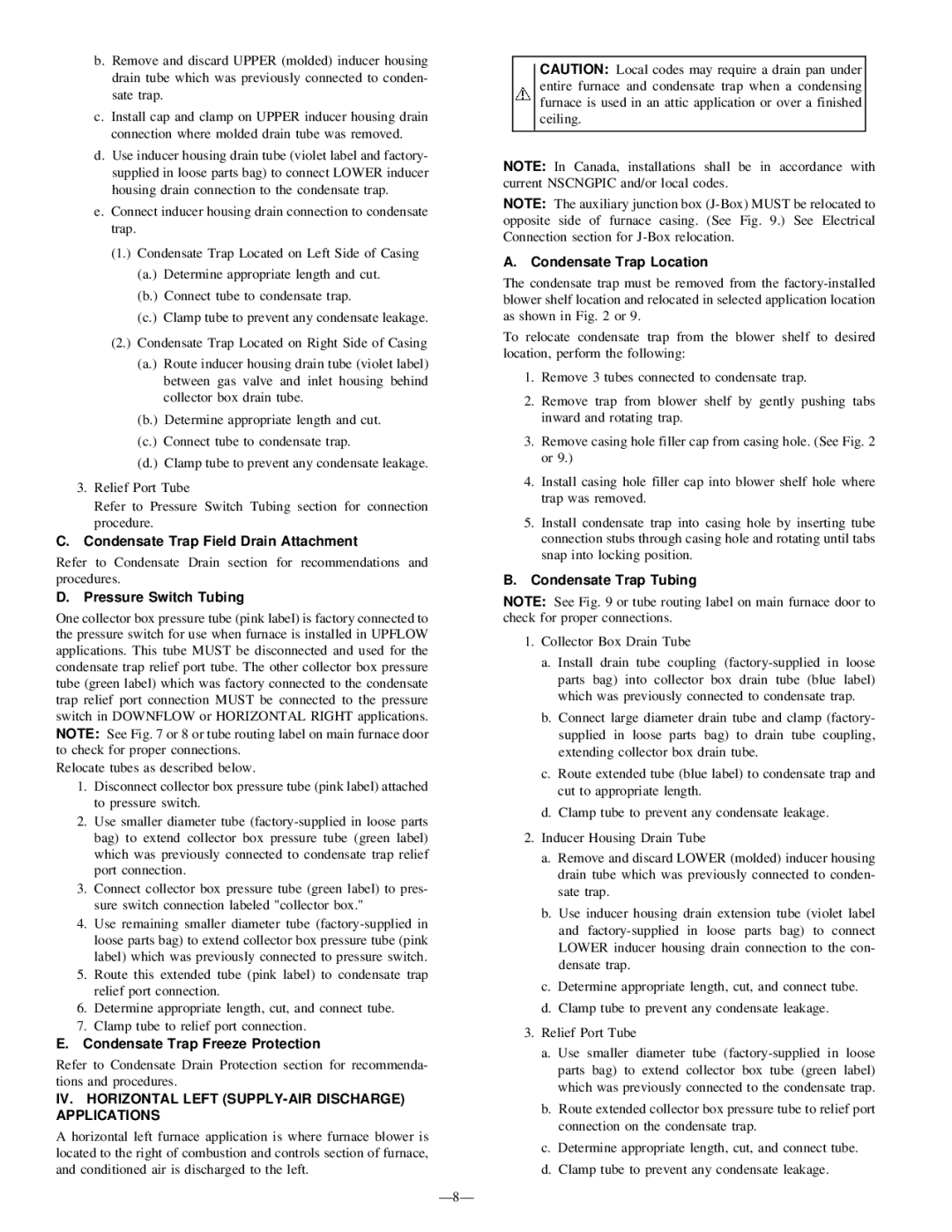b.Remove and discard UPPER (molded) inducer housing drain tube which was previously connected to conden- sate trap.
c.Install cap and clamp on UPPER inducer housing drain connection where molded drain tube was removed.
d.Use inducer housing drain tube (violet label and factory- supplied in loose parts bag) to connect LOWER inducer housing drain connection to the condensate trap.
e.Connect inducer housing drain connection to condensate trap.
(1.) | Condensate Trap Located on Left Side of Casing |
| (a.) | Determine appropriate length and cut. |
| (b.) | Connect tube to condensate trap. |
| (c.) | Clamp tube to prevent any condensate leakage. |
(2.) | Condensate Trap Located on Right Side of Casing |
| (a.) | Route inducer housing drain tube (violet label) |
| | between gas valve and inlet housing behind |
| | collector box drain tube. |
| (b.) | Determine appropriate length and cut. |
| (c.) | Connect tube to condensate trap. |
| (d.) | Clamp tube to prevent any condensate leakage. |
3.Relief Port Tube
Refer to Pressure Switch Tubing section for connection procedure.
C.Condensate Trap Field Drain Attachment
Refer to Condensate Drain section for recommendations and procedures.
D.Pressure Switch Tubing
One collector box pressure tube (pink label) is factory connected to the pressure switch for use when furnace is installed in UPFLOW applications. This tube MUST be disconnected and used for the condensate trap relief port tube. The other collector box pressure tube (green label) which was factory connected to the condensate trap relief port connection MUST be connected to the pressure switch in DOWNFLOW or HORIZONTAL RIGHT applications. NOTE: See Fig. 7 or 8 or tube routing label on main furnace door to check for proper connections.
Relocate tubes as described below.
1.Disconnect collector box pressure tube (pink label) attached to pressure switch.
2.Use smaller diameter tube (factory-supplied in loose parts bag) to extend collector box pressure tube (green label) which was previously connected to condensate trap relief port connection.
3.Connect collector box pressure tube (green label) to pres- sure switch connection labeled "collector box."
4.Use remaining smaller diameter tube (factory-supplied in loose parts bag) to extend collector box pressure tube (pink label) which was previously connected to pressure switch.
5.Route this extended tube (pink label) to condensate trap relief port connection.
6.Determine appropriate length, cut, and connect tube.
7.Clamp tube to relief port connection.
E. Condensate Trap Freeze Protection
Refer to Condensate Drain Protection section for recommenda- tions and procedures.
IV. HORIZONTAL LEFT (SUPPLY-AIR DISCHARGE) APPLICATIONS
A horizontal left furnace application is where furnace blower is located to the right of combustion and controls section of furnace, and conditioned air is discharged to the left.
Ð8Ð
CAUTION: Local codes may require a drain pan under entire furnace and condensate trap when a condensing furnace is used in an attic application or over a finished ceiling.
NOTE: In Canada, installations shall be in accordance with current NSCNGPIC and/or local codes.
NOTE: The auxiliary junction box (J-Box) MUST be relocated to opposite side of furnace casing. (See Fig. 9.) See Electrical Connection section for J-Box relocation.
A.Condensate Trap Location
The condensate trap must be removed from the factory-installed blower shelf location and relocated in selected application location as shown in Fig. 2 or 9.
To relocate condensate trap from the blower shelf to desired location, perform the following:
1.Remove 3 tubes connected to condensate trap.
2.Remove trap from blower shelf by gently pushing tabs inward and rotating trap.
3.Remove casing hole filler cap from casing hole. (See Fig. 2 or 9.)
4.Install casing hole filler cap into blower shelf hole where trap was removed.
5.Install condensate trap into casing hole by inserting tube connection stubs through casing hole and rotating until tabs snap into locking position.
B.Condensate Trap Tubing
NOTE: See Fig. 9 or tube routing label on main furnace door to check for proper connections.
1.Collector Box Drain Tube
a.Install drain tube coupling (factory-supplied in loose parts bag) into collector box drain tube (blue label) which was previously connected to condensate trap.
b.Connect large diameter drain tube and clamp (factory- supplied in loose parts bag) to drain tube coupling, extending collector box drain tube.
c.Route extended tube (blue label) to condensate trap and cut to appropriate length.
d.Clamp tube to prevent any condensate leakage.
2.Inducer Housing Drain Tube
a.Remove and discard LOWER (molded) inducer housing drain tube which was previously connected to conden- sate trap.
b.Use inducer housing drain extension tube (violet label and factory-supplied in loose parts bag) to connect LOWER inducer housing drain connection to the con- densate trap.
c.Determine appropriate length, cut, and connect tube.
d.Clamp tube to prevent any condensate leakage.
3.Relief Port Tube
a.Use smaller diameter tube (factory-supplied in loose parts bag) to extend collector box tube (green label) which was previously connected to the condensate trap.
b.Route extended collector box pressure tube to relief port connection on the condensate trap.
c.Determine appropriate length, cut, and connect tube.
d.Clamp tube to prevent any condensate leakage.

